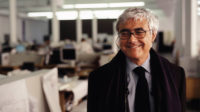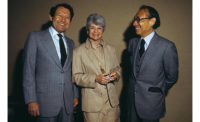Rodolfo Machado and Jorge Silvetti Pay Tribute to the Late Rafael Viñoly




Architects & Firms
Celebrated Uruguayan architect Rafael Viñoly died unexpectedly of an aneurysm, in New York, on March 2 at the age of 78. A lifetime of friendship with him is remembered by his schoolmates in Argentina, Rodolfo Machado and Jorge Silvetti, founders of Boston-based Machado Silvetti. What follows is a chronology of their shared experiences, written by Machado and interspersed with poignant memories from Silvetti, from their first meetings with Viñoly to their last.
RM: After the shock of Rafael’s passing, the memories came, a torrent of images from the past—flashes, the special tone of his voice. After a while, one begins to sort them out, to put order to the flow, to reason out our shared lives.

Viñoly’s 432 Park Avenue towers over the Chrysler
Building on the May 2015 cover of RECORD.
Image © James Ewing / Architectural Record
There were episodes in my and Jorge Silvetti’s lives that brought us together with Rafael, times when we experienced firsthand his ferocious capacity for life, his multiple intelligences—we may say an artistic (musical, mostly) intelligence, the special intelligence and multiple sensitivities one needs to become a successful architect, plus the cold, piercing intelligence of the businessman.
I will mention four of those episodes—moments of duress, transition, and definition. I write them down chronologically, from youth to maturity, and consequently geographically, from the south to the north of the Americas in which we live.
Buenos Aires, 1966: Graduation
We met at Facultad de Arquitectura y Urbanismo at the Universidad de Buenos Aires in the early ’60s. I cannot remember how—just kids crossing paths at school, all of us put together to study under the best teachers of the day. We were immediately drawn to one another.
Then the military dictatorship happened, and on July 29—during “La noche de las Bastones largos,” as it is known in Argentinean history—the University was taken over by the military. It was closed, our lives disrupted. Rafael and I were in a group that did its final thesis project in lockdown—policed and under great traumatic stress, we graduated. Rafael showed great strength and determination.
JS: What brought us together—and at times we were inseparable—were our common interests in music and in drawing, two artistic practices that we had learned and experienced since infancy, prior to our journey into architecture.
New York offered him the proper platform from which, until he passed away last month, he never stopped looking high and far, as if there were nothing in the field of architecture that he saw as too difficult, too big, or too complicated to tackle.

The Maene-Viñoly Concert Grand piano. Photo courtesy Rafael Viñoly Architects
There was something marvelous and contagious in the persuasive optimism with which he approached some of the most complicated and thorny architectural and urban problems, problems that would have scared most and left some paralyzed. His attraction to problem-solving endeavors, his search for extreme precision in resolving the tension between a design’s form and performance, and his ever-daring attitude to break well-established and resistant design conventions, all bore fruit late in his life in one of his most delicate and rigorous transformative designs—one that required the courage of the brave and the coolness of the sure of mind—the daring attempt to redesign one of the sacred cows of Western cultural artifacts: the grand piano.
Interestingly, in our last meeting, a lunch we had in Boston a few months ago when we were able to finally meet after the pandemic, we had, as usual, a great animated conversation, intelligent, funny, entertaining, and profound—and, also as usual, we talked more about music than about architecture!
Boston, 1978: Becoming North Americans
RM: Knowing of Rafael’s desire to leave Buenos Aires, Jorge invited him to teach at Harvard, at the GSD. Rafael came with his wife, Diana, and their children; they were, like us, immigrants then.
Many long, bonding conversations took place amongst the four of us. How to adapt, how to live here? The costs of exile, the pains of language acquisition, cultural misunderstandings, our otherness . . . Rafael, pragmatic and clear-minded, adapted quickly.
Providence, circa 1980: Teaching
Well aware of Rafael’s talents, I invited him to teach at the Rhode Island School of Design, in the Department of Architecture, which I chaired.
Many seminar-like discussions joyfully took place. How to teach undergraduates, to better transmit architecture? The value of the art-school pedagogical model versus university teaching, the notion of authorship, the deep continuity of architecture, images, styles, tastes, etc. Rafael—strong-minded, convincing, charismatic, controversial, was a good teacher.
Boston, New York, and beyond, from the mid-80s on: Practicing
On and on we conversed—the same haunting subjects, held in various locales such as our offices, the Princeton campus (where we both worked), occasionally our homes.

The Tokyo International Forum. Photo courtesy Rafael Viñoly Architects
We discussed ways of practicing, how to make enough money, the current devaluation of the architect, how to win competitions, or to win the best projects—all of it. As always, we had in Rafael a brilliant, most intelligent, engaged interlocutor.
JS: With his brilliant mind’s ability at synthesizing complex problems, his rich repertoire of formal devices, and techniques acquired since an early age practicing drawing and painting, and the sense of proportion native to his musical sensibility, Rafael would push the “parti” method—that distinctive pedagogical component of Beaux-Arts education, which survived in our school of the 1960s—to limits beyond and unknown to its historical sources, imbuing each of his projects with formal clarity and formidable image power.
RM: We practiced architecture well, but differently. Over time, we found our paths, and those paths took us a certain distance from each other. That is regrettable, and sad—as is his premature death.






